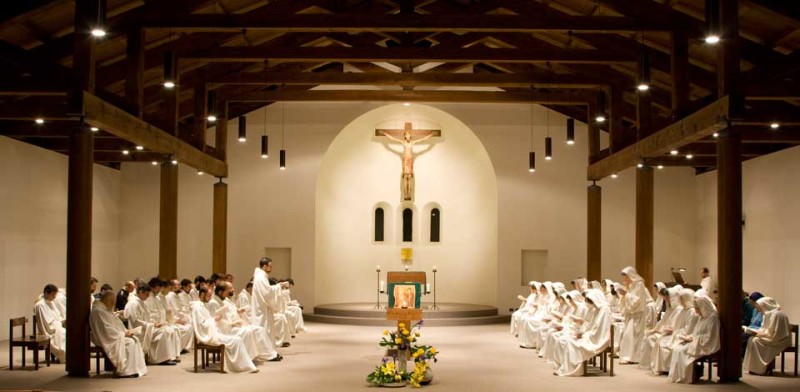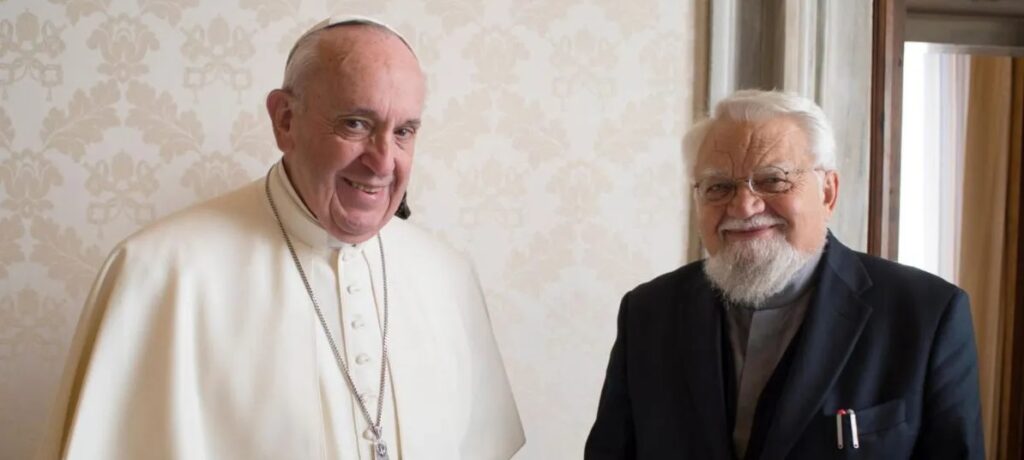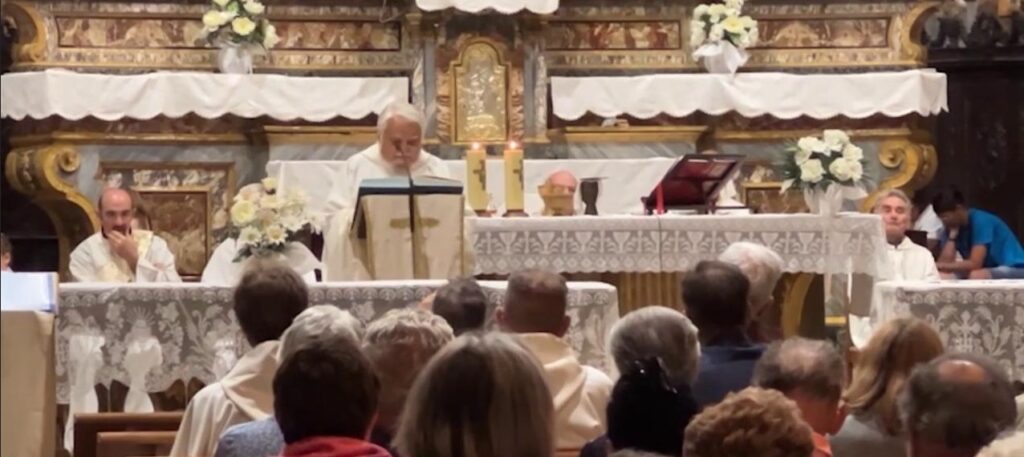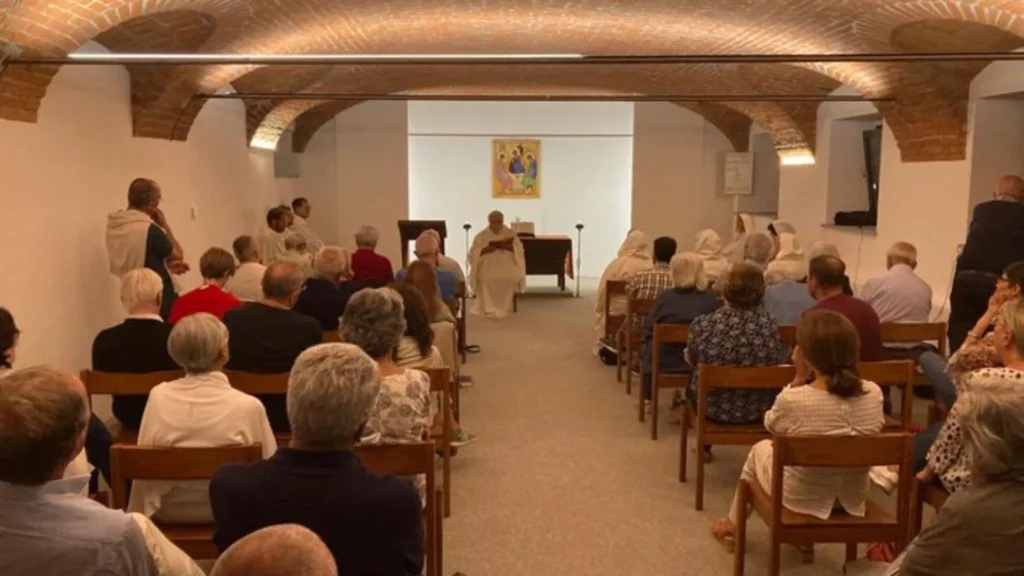The Madia House, where Enzo Bianchi founded his new "community of Bose".
Edit: wow, Madia house even has solar panels! How ecological!
One of Pope Francis' strange relationships is that with Enzo Bianchi, the founder of the Community of Bose, who left its foundation in 2020, was removed involuntarily.
The monastic community of the “false prophet”
In 1965, Bianchi founded the (basic) Community of Bose, an ecumenical, monastic lay community of both sexes that did not exist under canon law whose “prior” he called himself. For years the “project” was supported by the Italian Bishops’ Conference. From the beginning of his pontificate, Pope Francis also showed particular sympathy for this progressive flagship project and appointed Bianchi Consultor. Bianchi left no stone unturned to attract attention through provocation. He has done this even more since Francis took office.
He explained that there is “no natural family” because the family form is a product of society that Jesus said nothing about homosexuality, which is why the Church should remain silent about the fact that Fatima is a “hoax” is because “no credible God” is presented there, that Mary is “not a suitable role model for women” because it is associated with “unrealistic” demands and after the publication of Francis' eco-encyclical, Bianchi declared that there was, in a sense, a new Eleventh Commandment, namely “Love the earth as yourself “. In Bose there was already speculation about the actual abolition of the papacy.

In 2017, Bianchi, who was then approaching his 75th birthday, relinquished leadership of the Bose Community and appointed a new “prior” named Luciano Manicardi. However, Bianchi apparently imagined this change in such a way that he would still have sole say. This quickly led to internal conflicts and the formation of opposing camps. His successor wanted to have the community recognized under canon law and thus bring it into a regulated form. But Bianchi had always rejected that and continued to try to prevent it. He valued the “freedom of fools,” as a Roman canonist put it.
In order to change the mind of Bianchi, the false monk, false prior and false prophet, his Bose “project” was praised to all heavens and the proposal was put forward to make him a cardinal. He would become the first layman in the history of the College of Cardinals. Cardinals were originally deacons, priests or bishops, as is still expressed today in the three classes of the church senate, but never laymen. Today they are all bishops.
Alternatively, bishops discussed the possibility of ordaining Bianchi as a priest. Because Bianchi refused all flattery, it came to an ordeal that seemed impossible to solve without “patricide.” Serious mutual accusations and insinuations followed. It was about forgery of documents and something even more serious. All disputes revolved around questions of external form and therefore remained on the surface. It was never about questions of the content of the doctrine and Bianchi's heterodox views. Why not? Because everyone obviously agreed on this, including Rome.
The Roman intervention
In order not to let the progressive masterpiece sink in the disrepute, but to save it in time, the Holy See intervened and ordered Bianchi to leave the community.
Was this the overdue rejection of the “false prophet” from Bose? Not at all. Despite the request, nothing happened for a year. Bianchi's departure was not completed until 2021. On February 8th, the Pontifical Delegate ad nutum Sanctae Sedis, the Canossian Amedeo Cencini, appointed by Francis for the monastic community, issued a decree that he also consciously accepted. This was made public in order to increase the pressure on Bianchi. The “former prior,” as it says, had to leave Bose within a week and retreat to the former monastery of Cellole in San Gimignano. The Pope, to whom the decree was presented by Secretary of State Pietro Parolin in the sacristy of St. Peter's Basilica, approved it without even looking at it, saying: “Yes, yes, I approve”.
Father Cencini, just in passing, boasts that as the Pope's “executioner”, i.e. commissioner or delegate, he has closed more communities than kept them open. In Lombardy he is called in when seminarians are suspected of being homosexual, which naturally outrages homophile church circles per se. There are no statements available about his approach and decisions in the matter.

Janus-faced approach?
Francis had also expressly approved the decree for Bianchi's removal, but at the same time he was pursuing his own “accompanying measures”. On February 9th, the Pope wrote a letter to the “false prophet”, which effectively reached him at the same time as the decree. In it, Francis effusively declared himself to be a “spiritual son” of the founder of the Community of Bose. It was the former dean of the Faculty of Philosophy of the Pontifical Lateran University Msgr. Antonio Livi, the editor of the collected works of Cardinal Giuseppe Siri, who had criticized Bianchi as a “false prophet.” Francis is a “spiritual son” of the “false prophet”?
The papal letter was intended to make it easier for Bianchi to leave. Francis pathetically compared Bianchi's situation to that of the Lord on the Cross. In this situation there is only “darkness”; you only have “three or four friends” who “cannot save” you. All that remains is “obedience, like that of Jesus”.
Francis had sent his delegate to nail Bianchi “to the cross” in order to stick to the image used by the Pope, but at the same time assured Bianchi of his personal closeness and friendship. It was as if Francis was telling him, there are inescapably dark forces at work in the Vatican, but I will secretly help you. A dialectical highlight or villain?
Is there a substantive discussion of Bianchi’s “teachings” in the writing? Not in the slightest.
Almost three years have passed since then. The Vatican seems to have had few concrete ideas about what should happen to Bianchi and the four loyal followers who had to leave Bose with him. However, Francis and Bianchi maintained frequent correspondence during this time. Francis asked several times about the health of Bianchi, now 80 years old, who had to undergo two heart operations last year. Francis also expressed his wish to meet Bianchi in person again.
Last Saturday, December 16th, the time had come. Bianchi came to Santa Marta and was blessed by Francis. He also gave the papal blessing to the Madia House, Bianchi's new project. Francis also continued the dialectical game from the beginning of 2021 by appearing surprised by the State Secretariat's measures.
Incidentally, Francis does not seem to see or quickly forget the wounds that he himself inflicts.
With the Madia House, a second Bose is being created
After several stops, each directed by the State Secretariat, Enzo Bianchi and his four companions reached Albiano d'Ivrea, a small community at the foot of the Alps, around 50 kilometers north of Turin, in the spring. There he founded a “second Bose” in an agricultural building, again as a monastic community, but without canonical recognition. He explained to the daily newspaper La Stampa:
“I am not founding a canonically recognized community, but I want to be a coenobitic monk and not live as a Hermit.”

As a result of the disputes and Bianchi's removal, the number of members in Bose has fallen dramatically. Without the “guru” the community was no longer the same for many people. Instead, Bianchi is building a new “Bose” with Madia House. The buildings have been largely prepared so that he can invite anyone who wants to live in a community to join him.
Madia, pronounced Màdia, from Latin magida, means baking trough in Italian. Madia House can therefore be translated as a house where bread is prepared.
Through the reception by Pope Francis on Saturday, Enzo Bianchi was rehabilitated by his “spiritual son”, not formally but in fact, just as Francis likes it. The Pope encouraged Bianchi to build his “second evil.” This should also ensure the continued influx of “brothers” and “sisters”.
Bianchi can live out his final days in “brotherly community”. So much for lifestyle. However, it is doubtful that Bianchi was urged by Francis to stop acting as a “false prophet”.

Text: Giuseppe Nardi
Image: Facebook/Youtube/VaticanMedia
Trans: Tancred vekron99@hotmail.com
AMDG


No comments:
Post a Comment